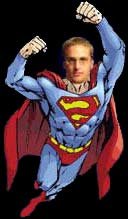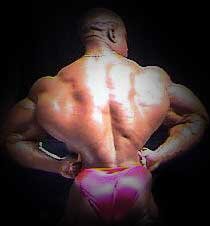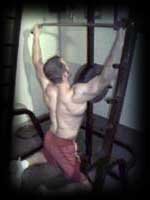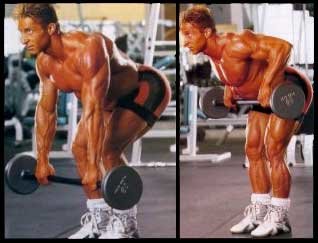
I suppose we should not be surprised that the back is the most neglected part of the body when it comes to lifting. I mean when someone asks you to flex you don't turn around and give them a lat spread, you can't bounce your back like you can your pecs but if you ever want to build a physique that turns heads onstage as well as on the beach you better work back. What's so great about having a well-built back? Well first of all you are less prone to lower back injury, which is very common nowadays. By working out and strengthening the back you reduce your chances of injury to it over time. Another advantage to having a well built back is that it will make you look wider and aid you in obtaining the trademark V-shape that all bodybuilders posses.
So how are you supposed to obtain a great back?
 Only a well thought out back routine will allow you to gain an optimal amount of muscle. First lets discuss back exercises. There are essentially three different types of movements for the back...pull ups or downs, rows, and pull overs. Pull ups and pull downs work the lats and upper middle back with more focus on the lats depending upon your hand placement. Rows target the upper inner back and the lats with more emphasis on the upper inner back. Pull overs are used to isolate the lats.
Only a well thought out back routine will allow you to gain an optimal amount of muscle. First lets discuss back exercises. There are essentially three different types of movements for the back...pull ups or downs, rows, and pull overs. Pull ups and pull downs work the lats and upper middle back with more focus on the lats depending upon your hand placement. Rows target the upper inner back and the lats with more emphasis on the upper inner back. Pull overs are used to isolate the lats.
You should have two goals when you work out your back... widening the back and thickening the back. Having a lot of back thickness doesn't do much good if your back is narrow and having a lot of width doesn't look as impressive if your back doesn't have a proportionate amount of thickness to it. So when working back the goal should be to thicken and widen your back.
Working the Back
Now that we've covered the basics it is time to give you my idea on how to work the back. In my experience trying to concentrate on thickening and widening the back in the same workout can be very tough to do. I found that when I concentrated on width first, I was lacking intensity when I tried to concentrate on thickness later in my workout. The opposite was also true when I started out concentrating on thickness my workout was lacking intensity when I tried to work on thickness later in the same workout. I knew I needed to come up with a solution to this problem since I needed intensity in both areas. I decided that I would alternate different back workouts each week. Week one would concentrate on width and week two would concentrate on thickness.
*Note* - all exercises are preceded by 1 to 2 warm-up sets of 10-15 reps.
Week one
Wide grip pull ups -3 sets to failure (as many as you can do with your body weight)
Close grip cable pull downs- 2 sets to failure of 6-12 reps
Machine pull overs- 2 sets to failure of 10-15 reps
Barbell Rows (medium width grip)- 2 sets to failure of 6-12 reps
Close grip cable rows- 2 sets to failure of 6-12 reps
Week two
Barbell Rows (medium grip)- 3 sets to failure of 6-12 reps
Close grip cable rows- 2 sets to failure of 6-12 reps
Underhand grip cable rows- 2 sets to failure or 6-12 reps
Pull ups (wide grip)- 2 sets to failure (as many as you can do with your body weight)
Close grip cable pull downs- 2 sets to failure of 6-12 reps
Now I'm going to talk a bit about proper repetition form. There are a couple of back exercises that people constantly do wrong, I see it in the gym everyday and I just shake my head. First off it goes without saying that all reps must be done with a full range of motion and using a slow descent during the eccentric (negative) part of the repetition. I take at least 5 seconds on every negative and up to 8 seconds. These two rules go without saying; full range of motion and a slow negative are essential to maximizing the amount of muscle fiber that you stimulate when you are working out.
The Exercises
Now onto discussing the exercises themselves. In my opinion the lift that the most people cheat on (besides bench press and squat) is the pull up. I have talked to a lot of people who say they can do 15-20 pull ups but  they have bodies that look like toothpicks. How can this be? Well they are cheating, they are using momentum to swing their body up and they aren't using a full range of motion. A pull up should start of with you simply hanging from the bar with a wide grip.
they have bodies that look like toothpicks. How can this be? Well they are cheating, they are using momentum to swing their body up and they aren't using a full range of motion. A pull up should start of with you simply hanging from the bar with a wide grip.
You should then flex their lats and then begin to pull yourself up. You should pull yourself up as high as you possibly can (your chin should be over the top of the bar). You should now flex hard for a peak contraction and SLOWLY lower yourself down until you are at the starting position again. Using this method I am only able to get about 12 reps on a good day.
When doing barbell rows the first thing you must remember is to always flex and keep your lower back arched, NEVER allow it to roll. By arching your lower back you more evenly distribute the load over your lower back, whereas when you round it you put more pressure on certain spots which can cause injury. You should bend over so that you are at about a 45-degree angle and using a medium width grip pull the bar up into your lower abdomen.

I also recommend using an overhand grip as whenever you use an overhand grip you put more stress on your back, whereas an underhand grip places more stress on the biceps. Using an underhand grip is also a bit more dangerous as the movement is more of a half curl than it is a row. Dorian Yates tore his bicep in 1994 while doing underhand grip barbell rows. He now advocates using an overhand grip and so do I. Do not move your back up and down in order to help you move the weight; the only part of your body that should move is your arms.
The last exercise I will talk about is cable rows. I see many people rocking back and forth when they do them, this is incorrect. Instead of rocking back and forth, keep your back held in place while leaning slightly back. Once again the only part of your body that should move is your arms.
You may have noticed that I do not have deadlifts in my routine and there is a reason for this. I do deadlifts on leg day. The back is used as more of a stabilizer muscle when doing deadlifts, it is not really a primary mover. Most of the lifting is actually done by the leg muscles. Since the back is a stabilizer muscle when doing deadlifts and squatting movements, it only makes sense to do deadlifts on leg day.
I hope this back workout gets you on your way to a thicker AND wider back!
As always, if you have any questions email me at biolayne@yahoo.com
